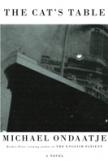Into the Deep
Michael Ondaatje set his award-winning novel The English Patient against the broad expanse of Italy and Egypt during World War II, but in his newest book, The Cat’s Table, he crafts a much more confined but no less richly imaginative setting, that of a cruise ship sailing from Ceylon to England in 1954. The tale opens with the narrator, who shares with the author the name Michael, recalling how, as an 11- year-old, he left his aunt and uncle for a 21-day ocean voyage to be reunited with his mother, who had left the family home some years previously.
This is a beautifully complex novel, filled with the turbulence of youthful emotions recalled in the relative tranquility of adulthood. The mature narrator treats the voyage as a call to memory and insight: “I try to imagine who the boy on the ship was.” Ondaatje presents vivid slices of the daily shipboard lives of the 11-year-old boy, his cousin Emily and his two companions, Cassius and Ramadhin.
Michael recalls carefree days on the ship, rising before dawn to sneak a swim in the first class pool: “Each day we had to do at least one thing that was forbidden.” He also records, in an examination booklet, snippets of overheard conversations, suggesting that his Ceylonese education in a strict Catholic school has not been interrupted so much as it has been transformed from conventional subjects to lessons in human nature.
The passenger ship Oronsay, an actual historical ship of the Orient Line, is something of an ark, its seven levels and 600 passengers representing a diverse cross-section of humanity. The ship contains a below-deck garden, a dog kennel and a mysterious prisoner who is watched closely by a retinue of guards. It exudes the atmospheric complexity of a Freudian dream awaiting interpretation. For example, hidden deeply within its interior is a mural of naked women that the three boys first hear about as a rumor and later discover as a taboo glimpse into their sexual futures. Also circulating through the ship are other rumors, of crimes minor and major, one of which leads to a dramatic confrontation worthy of any oceangoing swashbuckler tale.
The “Cat’s Table” of the title refers to the spot most distant from the captain’s table in the ship’s dining room, and serves as Ondaatje’s symbol for marginalization and humility. From the humble perspective of the cat’s table, Michael gains insight into the powerful: “Nothing much of lasting value ever happens at the head table, held together by a familiar rhetoric. Those who already have power continue to glide along the familiar rut they have made for themselves.”
The novel features eccentric wisdom figures, like the voracious reader Mr. Fonseka, who “seemed to draw forth an assurance or a calming quality from the books he read. He’d gaze into an unimaginable distance.... He had a serenity that came with the choice of the life he wanted to live.” Mr. Mazappa, the ship’s pianist, sings bawdy lyrics to introduce the boys to experiences of love and loss that they have no experiential base to grasp. Michael recalls the first stirrings of romantic and sexual desire: “Where had it come from? And was it a pleasure or a sadness, this life inside me? It was as if with its existence I was lacking something essential, like water.”
Years after his arrival in England, the narrator returns to the voyage as he retells the story to his own children. Memories of his two companions flood into his heart, and he sets out to solve a present-day mystery concerning Ramadhin. He also wrestles with mid-life questions as to whether in the final analysis he has a cold heart, whether he loved his friends enough and whether he has become a distracted, superficial person. An existential emptiness wracks him: “We all have an old knot in the heart we wish to loosen and untie.”
This novel will not quicken the reader’s pulse with breathless high seas adventures, but it does offer powerful revelatory and arresting moments. One might say the book is not so much a page-turner as it is a “page-holder” with many moments to savor and to ponder. Ondaatje masterfully captures the stream of consciousness and conflicts that swirl about and within the deepening interiority of a sensitive young boy.
Ondaatje aptly selected for his novel’s epigraph a passage from Conrad’s novella Youth dealing with perspective. It reads in part, “This is how I see the East.... I see it always from a small boat.” The 21 days aboard the Olonsay prove to be a turning point in Michael’s consciousness. Everything that happens later is perceived by the adult Michael through this crucial transitional period in his life.
Emily Dickinson famously wrote, “There is no Frigate like a Book/ To take us Lands away.” Ondaatje’s novel offers readers the double literary consolation of providing a book that at one level deals with a literal ship whisking people to far-off lands, while at another level the novel invites us to a more symbolic journey to attain a deeper, wiser awareness of where we have been and who we have become.
This article also appeared in print, under the headline “Into the Deep,” in the April 9, 2012, issue.








